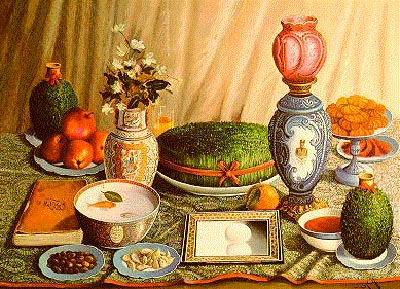1- Spring Cleaning
Nowruz is the most important holiday in Iran. Preparations for Nowruz begin in the month Esfand (or Espand), the last month of winter in the Persian solar calendar. Before the two week celebration Persians and other Indo-Iranian groups (Kurds, Azarbaijanis and Balochs) start preparing for the Nowruz with a major spring-cleaning of their houses, the purchase of new clothes to wear for the new year and the purchase of flowers (in particular the hyacinth and the tulip are popular and conspicuous). Spring cleaning, or Khouneh Tekouni (literally means 'shaking the house') or 'complete cleaning of the house' is commonly performed before Nowruz.
In association with the "rebirth of nature", extensive spring-cleaning is a national tradition observed by almost every household in Iran. This is also extended to personal attire, and it is customary to buy at least one set of new clothes. On the New Year's Day, families dress in their new clothes and start the twelve-day celebrations by visiting the elders of their family, then the rest of their family and finally their friends. On the thirteenth day families leave their homes and picnic outdoors.
2- Haft Sin or the Seven S’s:

Haft Sîn (Persian: هفت سین) or the seven 'S's is a major traditional table setting of Nowruz, the traditional Iranian spring celebration.Today The haft sin table includes seven specific items starting with the letter 'S' or Sīn (س) in the Persian alphabet. The items symbolically correspond to seven creations and holy immortals called Amesha Sepanta protecting them. The seven elements of Life, namely Fire, Earth, Water, Air, Plants, Animals, and Human, are represented. They also have Astrological correlations to five planets Mercury, Venus, Mars, Jupiter, Saturn, and Sun and Moon. With the advent of Islam the word Amesha Sepanta shortened to and eventually was remembered by just the letter S and the number 7. The Haft Sin has evolved over time, but has kept its symbolism. Traditionally, families attempt to set as beautiful a Haft Sīn table as they can, as it is not only of traditional and spiritual value, but also noticed by visitors during Nowruzi visitations and is a reflection of their good taste.
The general Haft Sīn items are:
sabzeh - wheat, barley or lentil sprouts growing in a dish - symbolizing rebirth
samanu - a sweet pudding made from wheat germ - symbolizing affluence
senjed - the dried fruit of the oleaster tree - symbolizing love
sīr - garlic - symbolizing medicine
sīb - apples - symbolizing beauty and health
somaq - sumac berries - symbolizing (the color of) sunrise
serkeh - vinegar - symbolizing age and patience.
3- Visiting Family and Friends:
During the Nowruz holidays, people are expected to visit one another (mostly limited to families, friends and neighbors) in the form of short house visits, which are usually reciprocated. Typically, on the first day of Nowruz, family members gather around the table, with the Haft Seen on the table or set next to it, and await the exact moment of the arrival of the spring. At that time gifts are exchanged. Later in the day, the first house visits are paid to the most senior family members. Typically, the youth will visit the elders first, and the elders return their visit later. When in previous year, a family member is deceased, the tradition is to visit that family first (among the elders). The visits naturally have to be relatively short, otherwise one will not be able to visit everybody on their list. A typical visit is around 30 minutes, where you often run into other visiting relatives and friends who happen to be paying a visit to the same house at that time. Because of the house visits, you make sure you have a sufficient supply of pastry, cookies, fresh and dried fruits and special nuts on hand, as you typically serve your visitors with these items with tea or sherbet. Many Iranians will throw large Nowruz parties in a central location as a way of dealing with the long distances between groups of friends and family.


